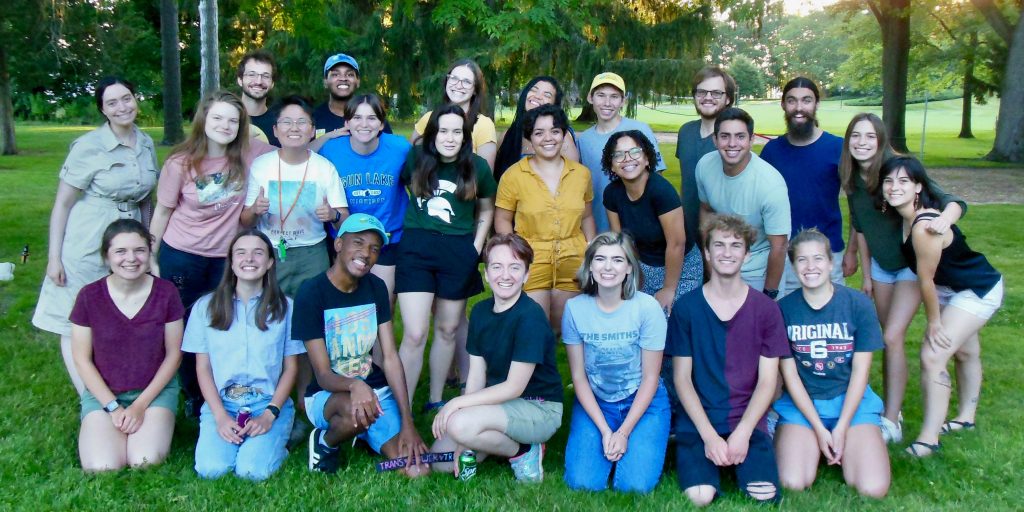As a student in the Undergraduate Research Apprenticeship program, or URA, at the W.K. Kellogg Biological Station, you get a little taste of everything. From research to classes to social events, there’s something here for everyone.
Research was the main thing that attracted me to KBS. I’ve conducted research on Michigan State University’s main campus, and loved it, but I was missing a large part of the research experience—field work. So having the opportunity to conduct hands-on research in one of the longest-running Long-term Ecological Research program sites was immediately appealing. Still, I didn’t quite know what to expect.
Small surprises in the field
 My typical field day started at 9 a.m. at the LTER site. We worked primarily in the T7 areas, which are early-successional plant communities. I helped throughout the LTER wherever extra help was needed—from light construction work to field irrigation to sensor cable management.
My typical field day started at 9 a.m. at the LTER site. We worked primarily in the T7 areas, which are early-successional plant communities. I helped throughout the LTER wherever extra help was needed—from light construction work to field irrigation to sensor cable management.
One of my main tasks was to help collect phenology data. Originally, I worked as an assistant to my mentor, Mark Hammond, and together we would note whether plants were flowering or not. But as the summer progressed and I learned more about the plants, I was able to collect the phenology measurements by myself.
During my time in the field, I noticed some of the goldenrod plants we study (Solidago canadensis) had these interesting growths on them. After some investigating, I learned that these were called galls, and they were formed by different species of flies. I began wondering if these galls would be affected by the warming and drought treatments we were working on, and created my own project to investigate!
As of midsummer, the warming treatments were affecting the plants’ growth; plants undergoing warming treatments are taller than non-warmed plants. However, there aren’t any initial effects on the galls quite yet. The drought treatment just started, so there’s no obvious effects of that yet. Luckily, my lab has been super supportive of this independent project, and I have the opportunity to continue pursuing this project into the upcoming fall semester!
A little time together means a lot
Cramming an entire semester’s worth of content into 10 classes sounds incredibly intimidating. And at first, it definitely was. How was I supposed to learn all about wetlands in just five weeks, especially after an entire year of online school? However, I can honestly say that taking the class was an incredible experience.
It’s not like your typical class. We went on field trips every day to visit local sites, and got hands-on experience doing things like wetland mitigation and delineation. We even got to see some endangered species along the way! From kayaking the Kalamazoo River to walking the boardwalk at Bishop’s Bog, we visited a wide variety of local wetlands and saw firsthand how wetlands are being managed and the mitigation efforts to protect these vital habitats.
After living through a global pandemic while being socially distanced, being able to spend a summer connecting with new people was invigorating. Being surrounded by like-minded people, all passionate about science and nature was really refreshing. The connections you make along the way are long-lasting, and I have made so many genuine friendships during my time here. The weekend bonfires, late night conversations, and trips we took together will be memories I cherish forever. The best part of KBS by far was being able to spend time with each other.
Whether your main interest with the URA program is research, classes, or just being able to meet new people in a really cool setting, this program will not disappoint. The connections—both professional and personal—are priceless, and will stay with me far into my future. I’m so glad I took the chance and applied for the program. It truly has been one of the best summer experiences I’ve had in a while.
~~~~~~~~~~~~~~~~~~~~
Emily Parker is a junior at Michigan State University. Her KBS mentor in the Zarnetske Lab was Mark Hammond. Her KBS summer experience was made possible in part with funding from the George H. Lauff Scholarship Fund and the Residential Opportunities at Kellogg Station Scholarship.
~~~~~~~~~~~~~~~~~~~~


A legacy of conservation; a commitment to sustainability.
3700 E. Gull Lake Drive
Hickory Corners, MI 49060
(269) 671-5117
info@kbs.msu.edu